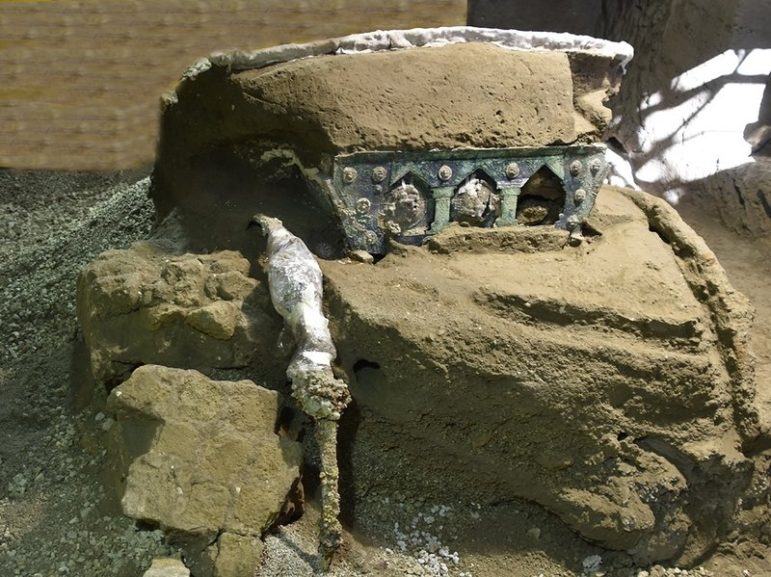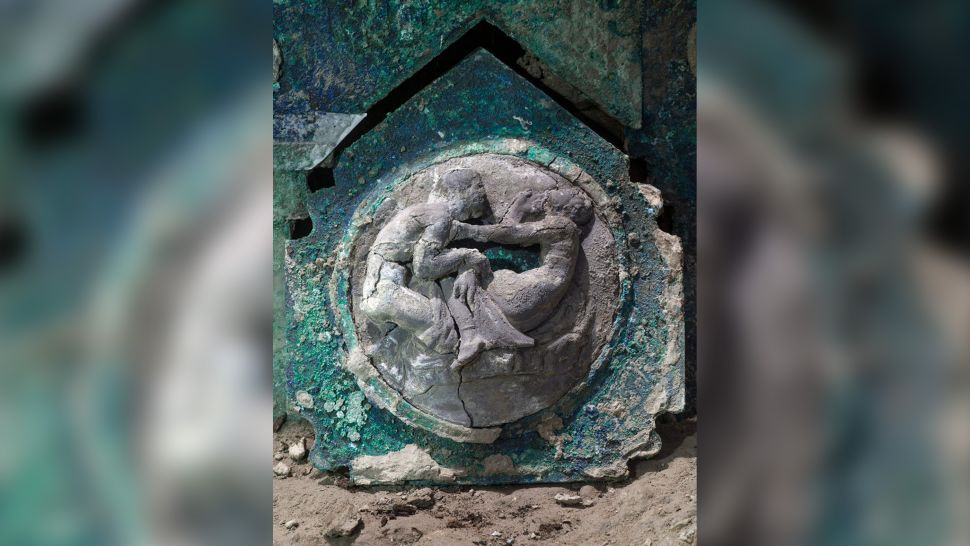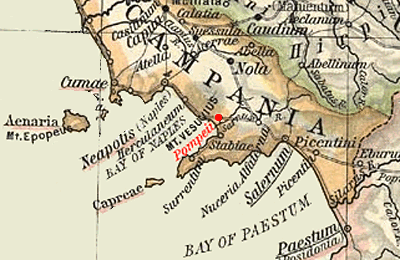NAPLES, Italy – On February 27, officials from the Archaeological Park of Pompeii announced that they had found an intact ceremonial chariot, a pilentum, the first found in Italy.

Image credit: Luigi Spina – courtesy of Archaeological Park of Pompeii
Linked to priestesses and lay females, pilentums played a role in Roman political and religious rituals. Officials from the Archaeological Park of Pompeii suggested that in Roman wedding rituals, this pilentum may have taken the bride to her new household.
Excavators found the chariot near an ancient villa about a half mile (0.8 km) northwest of Pompeii. Today that area is known as Civita Giulianna. That villa would have had a panoramic view of the Mediterranean.
The chariot still had its four wheels and decorations of bronze and tin. They also found remains of mineralized wood and imprints of organic materials such as ropes and floral decorations.
In an NPR article, Eric Poehler, who studies traffic in ancient Pompeii, said “This is an outright fancy, fancy car.”
Poehler said this was a Lamborghini compared to the normal station wagon or family sedan. Like a Lamborghini, this chariot was for the elite.
Archaeologists have now moved all elements to the laboratory of the Archaeological Park. Next, lab workers will remove volcanic debris and restore the chariot.
The portico
The ancient owners of the chariot had left it in a portico, a structure that has a roof and is supported by columns but has no walls, per se, rather like an ancient carport. The portico faced a stable and opened out into a courtyard on the other end. The portico functioned like a modern garage and protected the chariot from the eruption of Vesuvius.
The wooden beams of English oak in the portico’s ceiling survived the eruption. The Romans commonly used that oak for structural purposes. A beechwood door connected the portico with the nearby stable. In 2018, excavators found the remains of three horses in that stable, with one of those horses still wearing its harness.
Released in June of 2020, Massimo Osanna, director of the Archaeological Park of Pompeii, narrated this video that discusses some of the other amazing discoveries that have been uncovered.
What is a pilentum?
Massimo Osanna, Director of the Archaeological Park of Pompeii, described the chariot as a ceremonial chariot or “pilentum.” Those chariots differed from workaday chariots. Pilentums would have been used in “community festivities, parades, and processions.”
Archaeologists have found only one other ceremonial chariot. They found that one fifteen years ago, in Thrace, near the Greek-Bulgarian border. That chariot, however, had fewer decorations.
Most images of ancient chariots show two-wheeled vehicles. This chariot had four wheels, marking it as a Pilentum. This chariot’s seat could accommodate one or two people. It also had arm and backrests.
According to officials from the Archaeological Park of Pompeii, the sides of the chariot featured “alternating engraved bronze sheet and red and black painted wooden panels.”
The rear of the chariot had a “complex and extensive decorative system featuring three distinct registers with a succession of bronze and tin medallions with figurative scenes.”
The medallions were set in bronze. They showed male and female figures in relief. The statement form the Archaeological Park descried the medallions as showing “erotic scenes.” Some of the medallions had images of Cupids.
Marriage customs and rituals among Roman citizens
According to the University of Connecticut website, elite Roman marriages involved a contract between patriarchal families. Elite Roman marriages more resembled a politico-economic alliance between families than a romantic relationship.
The Roman marriage ritual transferred control of the woman from her father to her husband. At first, the husband retained the dowry. Later on in Roman history, women gained control of their dowries.
The Romans considered some dates unlucky for weddings. In Roman culture, weddings could not occur in February or May. Certain days were also prohibited: the Kalends (1st of the month), the Nones (nine days before the Ides), or Ides (15th or 13th day of the month).

A decorative erotic medallion of satyrs and nymphs on the ceremonial chariot (Image credit: Archaeological Park of Pompeii)
The bride would wear a long white robe, veil, and yellow shoes. The bride also wore a belt tied into a “knot of Hercules.” While her mother would dress her, only her husband could untie this “knot of Hercules.”
In a Roman wedding ritual, the bride and groom would stand together before a priest in the home of the bride’s father, and required at least 10 witnesses to be present. The bride and groom would chant the Roman wedding chant.
Translated into English, that chant consists of the following words, “When-and where-you are Gaius, I then-and there-am Gaia.”
The bride and groom would then sit facing the altar. Next, the priest would offer a cake to Jupiter. The bride and groom would then eat the cake. A feast would follow.
After the feast, the mother would hold the bride. The groom would then “attempt” to grab the bride from the mother. After that, the wedding party would then process to the husband’s house throwing nuts along the way. A pilentum may have been part of this procession
When the procession reached the husband’s house, the bride and groom would repeat the wedding chant. The husband would then carry her over the threshold. After that, they would invite the guests in.
People may find parts of the Roman wedding ritual familiar.
Pompeii
The 79 C.E. eruption of Vesuvius buried Pompeii under three meters (roughly 10 ft) of ash. In the 1500s, people first re-discovered Pompeii. Scientific excavations “only’ began in the 1700s.

Map of Campania during the Roman period, highlighting Pompeii.
Image credit: Extracted and adapted from The Historical Atlas by William R. Shepherd, 1911 – Public Domain
Archaeologists have only excavated about two/thirds of the site. The Smithsonian Magazine reported that the European Union-funded Great Pompeii Project has made many significant findings since 2012. Archaeologists found a snack bar. Items on that menu included snails and fish. They also found a “sorcerer’s kit.”
According to the BBC, that sorcerer’s kit consisted of crystals, scarab amulets, and gems, among other items. Unlike the ceremonial chariot, this kit belonged to a servant or slave. Archaeologists base this claim on the absence of gold and the presence of everyday objects from the world of women.
Despite more than 300 years of excavation, Pompeii still has something to teach us.
The Wild Hunt is not responsible for links to external content.
To join a conversation on this post:
Visit our The Wild Hunt subreddit! Point your favorite browser to https://www.reddit.com/r/The_Wild_Hunt_News/, then click “JOIN”. Make sure to click the bell, too, to be notified of new articles posted to our subreddit.